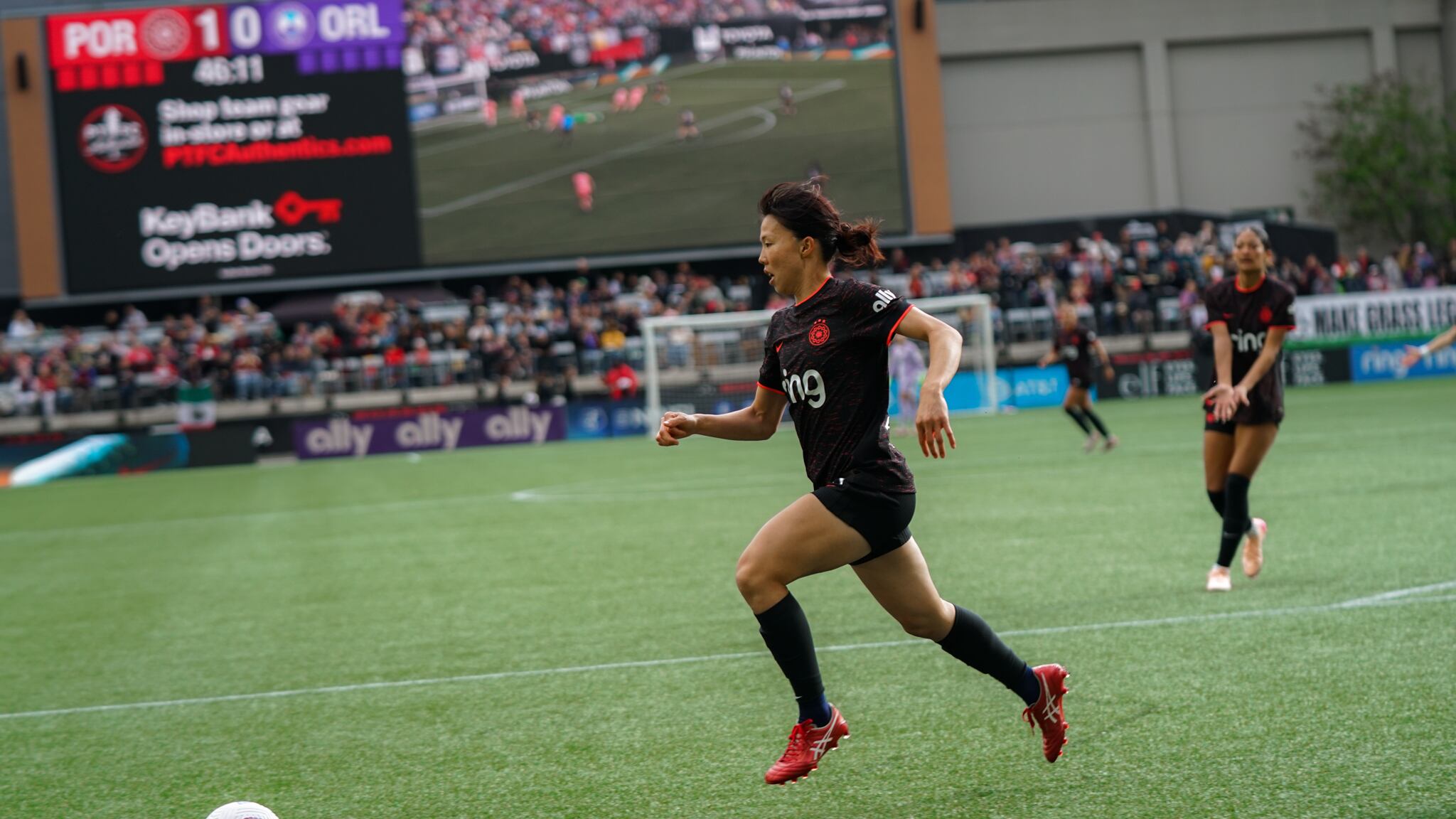The 2025 Portland Thorns are focused on playing with joy. It’s hard to imagine anyone on the pitch who embodies that quality more than Hina Sugita: smile on her face, dancing around defenders, fanning cool air on her teammates in the halftime locker room during a sweltering match against Club América Feminil in May.
Yet when she arrived in the United States from Kobe, Japan, three years ago, she wondered how she would cross the cultural and language barriers.
“I wanted to express my color, and I wanted to express my play style,” Sugita tells WW, speaking through a translator. “I wanted to have people understand how I play.”
Message delivered.
Sugita is now a key feature of Portland’s midfield, known for smooth passing, dancing with the ball at her feet, and then tracking back to intercept the ball on defense.
In the locker room, she’s just as charming. She brings back little gifts for her teammates from her excursions: fresh strawberries from the Portland Farmers Market, or hair sticks from an offseason trip to Japan for the claw clip-loving Coffey.
“She’s a terrific character,” Thorns head coach Rob Gale says. “Everybody enjoys Hina’s presence on the field, off the field. She loves her football. We love her expressing herself.”
In a year when new players abound, Sugita’s consistency, work rate, and ability to break defensive pressure are invaluable to the Thorns. It certainly doesn’t hurt that this is her fourth year with the club, which has allowed her plenty of time to build relationships at midfield with fellow team staples Sam Coffey, Olivia Moultrie and—over the past two years—Jessie Fleming.
Growing up in Kitakyushu in Southern Japan, Sugita was one of those kids who was raised around soccer players; her dad played, and so did her brother, and so, naturally, she played, too. She was mostly surrounded by boys on the soccer pitch. Sugita wanted to compete. “What really got me into soccer when I first started playing was the competition against boys,” she says. “I didn’t want to lose even though they were physically bigger and faster, and I really enjoyed the battles.”
But that competitive edge—and an assortment of youth soccer accomplishments, including captaining Japan’s U-17 team to its first U-17 World Cup title in 2014 and being named the tournament MVP in the process—didn’t translate into immediate success once she hit the club level.
Sugita started playing with three-time league champion INAC Kobe Leonessa out of high school in 2015 and made only a handful appearances all year. A number of Japan’s national team stars (including eight who were on the country’s 2011 World Cup-winning squad) were based in Kobe at the time, which meant Sugita was competing against her nation’s top talents for minutes at the age of 18.
Kobe valued technical accuracy—down to the minute details. It took Sugita time to adjust.
She was intimidated by the level of play and how the players around her communicated on the field, she says. Though she would come off the bench toward the end of a handful of matches, being on the field didn’t immediately bring her confidence. “I remember thinking that I didn’t even want to touch the ball,” she says, “because the team was already so structured and I didn’t know how to integrate myself there.”
“I was a bit overwhelmed at their skill level,” Sugita adds. “I wasn’t having a lot of fun at that time.”
By 2016, Sugita was a regular member of Kobe. She played in 29 games across all competitions (compared to six the year before), scored four goals and was named best young player in the Nadeshiko League.
Sugita eventually found her rhythm at Kobe and ended up learning from the team. She stopped comparing herself to her teammates and focused on her strengths instead (specifically, on reading the play and anticipating the movement on the field around her). Sugita loves competing—tackling a ball away from an opponent or burying a shot in the back of the net—and focusing on that and on being her best have helped her find joy and clarity in the way she plays today.
That doesn’t mean her transition to the NWSL was easy. American soccer is known for being direct, and it took Sugita time to adjust to the speedy vertical movement and pace of defending required in the league. Many of the people she plays with and against in the States also are taller than her. (Being 5-foot-4 myself, I refuse to call Sugita short at 5-foot-3, but she stands a couple of inches below many players in the league.)
There was also the culture shock of it all: Sugita says she’s realized she took her routine in Japan for granted. She’s developed new rituals for things she didn’t realize she appreciated until she didn’t have them in the States. She’ll sometimes bring matcha on away games or do calligraphy (not with a full brush set, but a regular pen) to ground herself, mentally.
But Sugita made it work, communicating through her play, meshing her style at midfield with that of the American Sam Coffey and Costa Rican Rocky Rodríguez, and helping the Thorns to an NWSL championship in her first season with the club. She worked to get back on defense, to show for the ball, to prove herself a reliable outlet on any part of the field. She has integrated herself into the style of the Thorns as a whole, establishing herself as a key feature of Portland’s midfield.
On the Thorns, Sugita is a strong defensive and offensive presence—able to disrupt play, win the ball for Portland, and advance the Thorns’ attack through a nifty bit of footwork or a well-weighted pass.
“She is an absolute delight and joy,” says Thorns co-captain Coffey. “Getting to play with her is one thing, but getting to know her as a person—she’s just the sweetest and kindest person and the heart and soul of our team.”
NEXT MATCH:
vs. Seattle Reign
1 pm Sunday, Aug. 10
Providence Park

